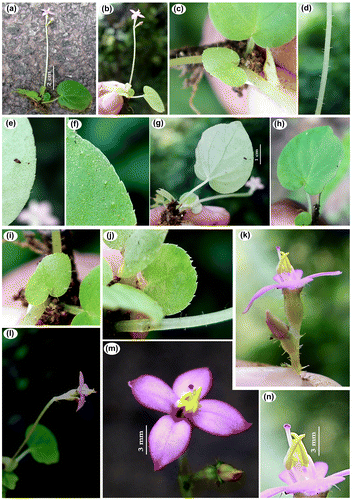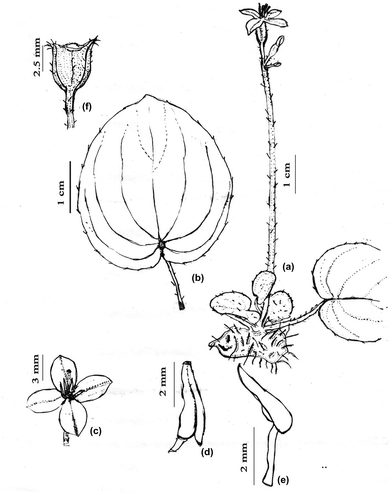Abstract
Phyllagathis indica is described as a new taxon from the Kuttikkanam Hills, Kerala section of the southern Western Ghats, India. The genus is new to the flora of India and hence has much phytogeographical significance. The diagnostic morphological characters, distribution, conservation status and images of the new species are presented in this paper.
Introduction
The southern Western Ghats, situated at the crossroads of the Indian peninsula and South Asia, is considered a significant biogeographical hotspot area of the world. It has a unique status as an ancestral area holding varied concentrations of endemic species. It is believed that biodiversity linkages of the Indian peninsula and South Asia might have occurred during the process of biological evolution due to multiple physical, climatological and geological changes (Szumik and Goloboff Citation2004; Mathew Citation2015). The botanical linkage of a number of plant species between these two regions has been reported by Sasidharan (Citation2013). Botanical explorations in the Kuttikkanam Hills of the southern Western Ghats (Figure ) during 2014–2015 have yielded some interesting specimens of the family Melastomataceae. Critical analysis of the literature as well as of herbarium specimens revealed that some of the collected specimens do not match the described species. This has resulted in the recognition of a novel species, which is described here as Phyllagathis indica.
Figure 1. Distribution map of Phyllagathis indica ((a) Peninsular India; (b) Kerala; (c) Red dot indicates the type locality in a part of enlarged map of Kerala).

The Old World, South Asian endemic genus Phyllagathis Blume (Melastomataceae: Sonerileae) comprising c. 56 species, was previously reported from south China, Vietnam, Laos, Thailand, Western Malaysia, Sumatra and Borneo (Cellinese Citation1997, Citation2002; Lin, Chen, and Yang Citation2015). This genus was originally described by Blume (Citation1831a, Citationb) as tetramerous with two whorls of four stamens. Later studies (Hansen Citation1993; Cellinese Citation1997) revealed that merism and stamen arrangement in this genus are unstable.
Material and methods
The data presented were obtained through the study of live specimens in the wild, available herbarium materials (K!, GH!, FRIM!) and an in-depth literature survey. Photographs are provided for better understanding of the morphological diversity. The herbarium specimens have been deposited at the TBGT (Jawaharlal Nehru Tropical Botanical Garden Herbarium, India).
Taxonomic treatment
Phyllagathis indica J. Mathew, Yohannan & Kad.V.George, sp. nov. (Figures and ).
Figure 2. Phyllagathis indica J.Mathew, Yohannan & Kad.V.George, sp.nov. ( (a,b) Habit; (c) Cordate leaf base; (d) A portion of peduncle with glandular hairs; (e,f) Leaf serrations (a portion enlarged, abaxial and upper sides); (g,h) Mature leaf (abaxial and upper view); (i,j) Young leaves with glandular hairs and deep serrations; (k) Opened flower; (l) Inflorescence; (m) Flower; (n) Dorsifixed stamen and crested stigma).

Figure 3. Phyllagathis indica J.Mathew, Yohannan & Kad.V.George, sp.nov. ( (a) Habit; (b) Mature leaf; (c) Flower; (d,e) Stamen; (f) Fruit)

Diagnosis
Phyllagathis indica, the first recorded species from the genus Phyllagathis in India, is geographically and morphologically distinct from other species of Phyllagathis. This new taxon shows some similarities to Phyllagathis tetrandra Diels and Phyllagathis tuberosa (C. Hansen) Cellin. & S.S. Renner in its appearance, but differs from these species in having four or five leaves with cordate base and serrate margins (two to four cordate, but entire leaves in each branch of P. tetrandra and single leaf with obtuse base and serrate margins in P. tuberosa), urceolate hypanthium (campanulate in P. tetrandra and P. tuberosa), and crested stigmatic surfaces for male cell reception (indicated in P. tetrandra and P. tuberosa with the reception centre in the middle of style). Prominent morphological differences distinguishing Phyllagathis indica from these species are indicated in Table .
Table 1. Morphological differences between Phyllagathis indica, Phyllagathis tetrandra and Phyllagathis tuberosa.
Type: India, southern Western Ghats, Kerala, Idukki district, Kuttikkanam Hills, Pullupara,1600 m, 9°43′07″ N, 77°16′06″ E, 2 November 2015, Jose Mathew 3072 (holo, TBGT!; iso, MSSRF!).
Description
Lithophytic, rhizomatous subacaulescent herbs, up to 10 cm in height. Roots slender, to 2 cm in length. Stem very short, 6–9 mm long and unbranched, clothed with minute glandular hairs of 0.05–0.08 mm long. Leaves 4–5, near the base, petioles 0.9–2.2 cm long, densely clothed with 1–2 mm long glandular hairs, lamina broadly ovate, 1–4 by 0.8—3.5 cm in size, six-prominent nerved, upper surfaces green, abaxial side white, base deeply cordate, apex mucronate or rounded, margin serrate; sparsely arranged glandular hairs on margins. Inflorescence a terminal scorpioid cyme, two- to five-flowered, 0.2 cm apart. Peduncle 6–9 cm long, white, cylindrical, with sparse minute hairs and brown glands. Bracts absent. Flowers 4-merous; pedicel 0.2–0.3 mm long, with sparse minute brown glands. Hypanthium slightly urceolate, 4–5 by 1.2 mm with glandular hairs of 2 mm in length. Sepals triangular, c. 0.4 mm long, greenish white, with a keel pointed into a short bristle, with sparse minute brown glands, caducous. Petals 4–5 by 2–2.5 mm in size, ovate with acuminate tip, pink. Stamens 4, episepalous, phyllagathoid, isomorphic, filaments c. 2 mm long, glabrous, dorsifixed. Anthers c. 3.5 mm long, yellow, slightly curved or thickened at base, inverted V shape, opening by two apical pores. Ovary half the length of hypanthium, adnate to it for about half of its length, anther pockets shallow, crown large, wide, lobes fully connate, placentae stalked. Style c. 7 mm long, glabrous. Stigma small crested, with crown-like pink-coloured appendages. Fruit cup-shaped or slightly urceolate, 8-ribbed, 4.5–6 by 4–5 mm in size. Seeds obovate, c. 0.5 mm in long, brown, beak short and blunt.
Phenology
Flowering and fruiting of the new species were recorded from September to November.
Etymology
The epithet (indica) has been selected to reflect the first and only known Phyllagathis species from India.
Additional specimen studied (paratypes)
Southern Western Ghats, Idukki district, Kaduvappara, 2 November 2015, Jose Mathew 3073 – flowering (TBGT!); Amalagiri top, 11 September 2015, Jose Mathew 2944 – sterile (SESH!); Panchalimedu, 11 September 2015, Jose Mathew 2956 – flowering and fruiting (SESH!).
Habitat and distribution
Found in crevices of rocky cliffs (alt. ± 1600 m) of the Kuttikkanam Hills of southern Western Ghats, 65 km away from Periyar Tiger Reserve, Kerala, India in association with Henckelia meeboldii (W.W.Sm. & Ramaswami) A.Wever & B.L.Burtt, Christisonia tubulosa (Wight) Benth. ex Hook. f., Crepidium resupinatum (G.Forst.) Szlach (= Seidenfia rheedei (Sw.) Szlach.) Seidenfia rheedei (Sw.) Szlach., Leucas lavandulifolia Sm. and Goodyera procera (Ker. Gawl.) Hook. Among those, the Henckelia and Christisonia species are endemic to southern Western Ghats and the other three species are southeastern Asian continental endemics. The co-occurrence of Phyllagathis (south Asian genus) with the Asiatic elements deserves further investigation on phytogeographical aspects.
Conservation status
The distribution is limited to a few plants at the four known /cited locations (each with c. 4–6 plants). The threat status of this species has been assigned as ‘Critically Endangered’ (CR 1ab and 2ab) as per the guidelines of IUCN (Citation2012). Its area of occupancy is < 1 km2. Based on the above observations, adequate measures should be adopted to ensure the protection of this species in its natural habitat. Moreover, further surveys for this species are suggested, which would need to be conducted in October or November when the northeastern monsoon starts.
Notes
Phyllagathis indica, the foremost Indian species in the genus is spectacular in having a tetramerous and haplostemonous condition. It has morphological similarities to P. tetrandra (China) and P. tuberosa (Thailand) with some aspects; but is distinguished from these two species. The prominent similarities and differences are listed in Table .
Notes on contributors
Jose Mathew Research Scholar in School of Environmental Sciences, Mahatma Gandhi University, Kottyam, Kerala, India., has written 25 articles related to plant taxonomy including the discovery of 11 taxa. Contribution: Designed research, performed field work, and wrote the paper.
Regy Yohannan Research Scholar in Department of Botany, Sree Narayana College, Kollam, Kerala, India., working in spermatophytes taxonomy. Contribution: Designed research, and performed field work.
Kadakasseril Varghese George KSCSTE Emeritus Scientist in Department of Botany, St. Berchmans College, Changanachery, Kerala, India., working in plant taxonomy and phytochemistry. Contribution: Designed research.
Disclosure statement
No potential conflict of interest was reported by the authors.
Acknowledgements
The authors are grateful to the Kerala Forest Department for permission to conduct research. The first author wishes to thank the curator of TBGT and the anonymous reviewers for helpful comments on the manuscript. The second author is grateful to Dr Devipriya, Associate Professor and Head, Department of Botany, S.N. College, Chempazanthy, Kerala, for encouragement. The third author expresses his gratitude to KSCSTE, Thiruvanthapuram, Kerala for providing support.
References
- Blume, C. L. 1831a. “Uber einige ostindische und besonders javanische Melastomataceen.” Flora 14: 507.
- Blume, C. L. 1831b. “Over eenige Oostindische, bijzonder Javaansche Melastomaceae.” Bijdragen tot de Natuurkundige Wetenschappen 6: 248.
- Cellinese, N. 1997. “Notes on the systematics and biogeography of the Sonerila generic alliance (Melastomataceae) with special focus on fruit characters.” Tropical Biodiversity 4: 83–93.
- Cellinese, N. 2002. “Revision of the genus Phyllagathis (Melastomataceae: Sonerileae). I. The species in Burma, Thailand, Peninsular Malaysia and Sumatra.” Blumea 47: 463–492.
- Hansen, C. 1993. “The genus Phyllagathis (Melastomataceae): characteristics, delimitations. The species in Indo-China and China.” Bulletin du Muséum National d’Histoire Naturelle. Section B, Adansonia Botanique Phytochimie 14(3–4): 355–428.
- IUCN, 2012. The red list of threatened species. Accessed December 20, 2015. http://www.iucnredlist.org/documents/summarystatistics/2012_2_RL_Stats_Table_2.pdf.
- Lin, C.-W., C.-F. Chen, and T.-Y. A. Yang. 2015. “Two new taxa of Melastomataceae Trib. Sonerileae: Phyllagathis rajah and Sonerila metallica from Batang Ai, Sarawak, Borneo.” Phytotaxa 201 (2): 122–130.
- Mathew, J. 2015. “Floristic and ethnobotanical studies of Achankovil forests, Western Ghats, Kerala.” Ph.D. Diss., Mahatma Gandhi University, Kerala, 800+XIVp.
- Sasidharan, N. 2013. Flowering plants of Kerala: CD-ROM. Version 2.0. Peechi, Kerala, India: Kerala Forest Research Institute.
- Szumik, C., and P. A. Goloboff. 2004. “Areas of endemism: an improved optimality criterion.” Systematic Biology 53: 968–977.
